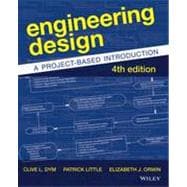Dym, Little and Orwin's Engineering Design: A Project-Based Introduction, 4th Edition gets students actively involved with conceptual design methods and project management tools. The book helps students acquire design skills as they experience the activity of design by doing design projects. It is equally suitable for use in project-based first-year courses, formal engineering design courses, and capstone project courses.








